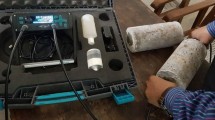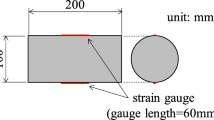Abstract
In this study, the age-dependent splitting and flexural tensile strength have been investigated by incorporating the various percentages of fly ash in the plain concrete mixes. The partial replacement of cement by fly ash was varied from 0 to 60% on an equal weight basis. Standard concrete specimens were cast for measuring splitting and flexural tensile strength at different ages, i.e., 7, 28, 56, 90, 150, and 180 days, for all plain and fly ash concrete mixes. Experimental results show that the fly ash produced a significant effect on the tensile strength of concrete mixes. It has been observed that the fly ash concrete mixes gain considerable tensile strength with respect to age beyond 28 days. In the low-calcium fly ash concrete mixes, the rate of development of tensile strength from 28 to 180 was observed higher in comparison with the plain concrete mixes. The assessment of the existing models for the estimation of age-dependent tensile strength recommended by design codes and researchers with experiments has also been done on various mixes of plain and fly ash concrete. New models to predict the age-dependent splitting and flexural tensile strength of concrete having different percentages of fly ash are proposed. The present experimental and analytical study will be helpful for the designers and practicing engineers for fixing preliminary dimensions of reinforced and prestressed concrete members and mix proportioning of low-calcium fly ash concrete mixes.

















Similar content being viewed by others
References
Legeron F, Paultre P (2000) Prediction of modulus of rupture of concrete. ACI Mater J 97(2):193–200
Wang XY, Park KB (2015) Analysis of compressive strength development of concrete containing high volume fly ash. Constr Build Mater 98:810–819. https://doi.org/10.1016/j.conbuildmat.2015.08.099
Sivasundaram V, Carette GG, Malhotra VM (1990) Selected properties of high-volume fly ash concretes. Concr Int 12(10):47–50
Monteiro P (2006) Concrete: microstructure, properties, and materials. McGraw-Hill Publishing, London
Khan AA, Cook WD, Mitchell D (1996) Tensile strength of low, medium, and high-strength concrete at early ages. ACI Mater J 94(2):487–493
Mehta PK, Monteiro PJ (2017) Concrete microstructure, properties and materials. http://matteopro.com/images/materiali-non-convenzionali/Concrete_microstrutture_-book.pdf
Zhou FP, Balendran RV, Jeary AP (1998) Size effect on flexural, splitting tensile and torsional strengths of high-strength concrete. Cem Concr Res 28:1725–1736. https://doi.org/10.1016/S0008-8846(98)00157-4
Duran-Herrera A, Juarez CA, Valdez P, Bentz DP (2011) Evaluation of sustainable high-volume fly ash concretes. Cem Concr Compos 33:39–45. https://doi.org/10.1016/j.cemconcomp.2010.09.020
Hashmi AF, Shariq M, Baqi A, Haq M (2020) Optimization of fly ash concrete mix–a solution for sustainable development. Mater Today Proc 26(2):3250–3256. https://doi.org/10.1016/j.matpr.2020.02.908
Huang CH, Lin SK, Chang CS, Chen HJ (2013) Mix proportions and mechanical properties of concrete containing very high volume of class F fly ash. Constr Build Mater 46:71–78. https://doi.org/10.1016/j.conbuildmat.2013.04.016
Yoshitake I, Komure H, Nassif AY, Fukumoto S (2013) Tensile properties of high volume fly-ash (HVFA) concrete with limestone aggregate. Constr Build Mater 49:101–109. https://doi.org/10.1016/j.conbuildmat.2013.08.020
Bouzoubaa N, Lachemi M (2001) Self-compacting concrete incorporating high volumes of class F fly ash preliminary results. Cem Concr Res 31(3):413–420. https://doi.org/10.1016/S0008-8846(00)00504-4
Lam L, Wong YL, Poon CS (1998) Effect of fly ash and silica fume on compressive and fracture behaviour of concrete. Cem Concr Res 28:271–283. https://doi.org/10.1016/S0008-8846(97)00269-X
Pilehvar S, Cao VD, Szczotok AM, Carmona M, Valentini L, Lanzón M, Kjøniksen AL (2018) Physical and mechanical properties of fly ash and slag geopolymer concrete containing different types of micro-encapsulated phase change materials. Constr Build Mater 173:28–39. https://doi.org/10.1016/j.conbuildmat.2018.04.016
Dragas J, Nikola T, Ignjatovic I, Marinkovic S (2016) Mechanical and time-dependent properties of high-volume fly ash concrete for structural use. Mag Concr Res 68:632–645. https://doi.org/10.1680/jmacr.15.00384
Singh P, Shukla A, Trivedi AS, Vardhan J (2018) An experimental investigation of mechanical properties of concrete due to the effect of fiber and fly ash. Int J Adv Res Ideas Innov Technol 4:1900–1905
Hashmi AF, Shariq M, Baqi A (2020) Flexural performance of high volume fly ash reinforced concrete beams and slabs. Structures 25:868–880. https://doi.org/10.1016/j.istruc.2020.03.071
Wee TH, Matsunaga Y, Watanabe Y, Sakai E (1995) Microstructure and strength properties of high strength concrete containing various mineral admixtures. Cem Concr Res 25:715–720. https://doi.org/10.1016/0008-8846(95)00061-G
Yoshitake I, Komure H, Nassif AY, Fukumoto S (2013) Tensile properties of high volume fly-ash (HVFA) concrete with limestone aggregate. Construction and Building Materials 49:101–109
Siddique R, Khatib JM (2010) Abrasion resistance and mechanical properties of high-volume fly ash concrete. Mater Struct 43(5):709–718. https://doi.org/10.1617/s11527-009-9523-x
Mimura Y, Yoshitake I, Zhang W (2011) Uniaxial tension test of slender reinforced early age concrete members. Materials 4(8):1345–1359. https://doi.org/10.3390/ma4081345
Yoshitake I, Rajabipour F, Mimura Y, Scanlon A (2012) A prediction method of tensile Young’s modulus of concrete at early age. Adv Civil Eng. https://doi.org/10.1155/2012/391214
Swaddiwudhipong S, Lu HR, Wee TH (2003) Direct tension test and tensile strain capacity of concrete at early age. Cem Concr Res 33(12):2077–2084. https://doi.org/10.1016/S0008-8846(03)00231-X
Zhang H, Bai L, Qi Y, Hong H, Neupane A, Pan Q (2020) Impact of splitting tensile properties and dynamic constitutive model of fly ash concrete. J Mater Civ Eng 32(8):04020225. https://doi.org/10.1061/(ASCE)MT.1943-5533.0003302
Sahoo S, Selvaraju AK (2020) Mechanical characterization of structural lightweight aggregate concrete made with sintered fly ash aggregates and synthetic fibers. Cem Concr Compos 113:103712. https://doi.org/10.1016/j.cemconcomp.2020.103712
Rao AV, Rao KS (2020) Effect of fly ash on strength of concrete. In: Circular economy and fly ash management, Springer, Singapore, pp 125–134. https://doi.org/10.1007/978-981-15-0014-5_9
Siddique R (2004) Performance characteristics of high-volume class F fly ash concrete. Cem Concr Res 34:487–493. https://doi.org/10.1016/j.cemconres.2003.09.002
Siddique R (2003) Effect of fine aggregate replacement with Class F fly ash on the mechanical properties of concrete. Cem Concr Res 33(4):539–547. https://doi.org/10.1016/S0008-8846(02)01000-1
Mehta A, Siddique R (2017) Properties of low-calcium fly ash based geopolymer concrete incorporating OPC as partial replacement of fly ash. Constr Build Mater 150:792–807. https://doi.org/10.1016/j.conbuildmat.2017.06.067
Shariq M, Prasad J (2019) Effect of ground granulated blast furnace slag on time-dependent tensile strength of concrete. Comput Concr 23(2):133–143. https://doi.org/10.12989/cac.2019.23.2.133
IS 1489 (part 1), (1991) Portland Pozzolana cement—specification part 1 (fly ash based). Bureau of Indian Standards, New Delhi
IS 4031 (Part 1–15) (1999) Indian standard methods of physical tests for hydraulic cement. Bureau of Indian Standards, New Delhi
IS 8112 (1997) Indian standard 43 grade ordinary Portland cement—specification. Bureau of Indian Standards, New Delhi
IS 3812-2003 (Part 1) (2003) Pulverized fuel ash—specification part 1 for use as Pozzolana in cement, cement mortar and concrete. Bureau of Indian Standards, New Delhi
IS 383 (2002) Specification for coarse and fine aggregate from natural sources for concrete. Bureau of Indian Standards, New Delhi
IS 10262 (2009) Recommended guidelines for concrete mix design. Bureau of Indian Standards, New Delhi
IS 516:1959 Reaffirmed (2004) Method of tests for strength of concrete. Bureau of Indian Standards, New Delhi
IS 5816:1999 Reaffirmed (2004) Splitting tensile strength of concrete—method of test. Bureau of Indian Standards, New Delhi
ACI 209 (1999) Prediction of creep and shrinkage, and temperature effects in concrete structures, ACI, Farmington Hills, Michigan, USA, ACI Committee, p 209
Larrard FD, Malier Y (1992) Engineering properties of very high performance concrete. In: Malier Y (ed) High performance concrete: from material to structure. E & FN Spon, London
Zain MFM, Mahmud HB, Ilham A, Faizal M (2002) Prediction of splitting tensile strength of high-performance concrete. Cem Concr Res 32:1251–1258. https://doi.org/10.1016/S0008-8846(02)00768-8
Zhao S, Ding X, Zhao M, Li C, Pei S (2017) Experimental study on tensile strength development of concrete with manufactured sand. Constr Build Mater 138:247–253. https://doi.org/10.1016/j.conbuildmat.2017.01.093
Oluokun FA, Burdette EG, Deatherage JH (1991) Splitting tensile strength and compressive strength relationship at early ages. ACI Mater J 88(2):115–121
Oluokun FA (1991) Prediction of concrete tensile strength from its compressive strength: evaluation of existing relations for normal weight concrete. ACI Mater J 88(3):302–309
Atici U (2011) Prediction of the strength of mineral admixture concrete using multivariable regression analysis and an artificial neural network. Expert Syst Appl 38:9609–9618. https://doi.org/10.1016/j.eswa.2011.01.156
Saridemir M (2016) Empirical modeling of flexural and splitting tensile strengths of concrete containing fly ash by GEP. Comput Concr 17(4):489–498. https://doi.org/10.12989/cac.2016.17.4.489
Pal S, Shariq M, Abbas H, Pandit AK, Masood A (2020) Strength characteristics and microstructure of hooked-end steel fiber reinforced concrete containing fly ash, bottom ash and their combination. Constr Build Mater 247:118530. https://doi.org/10.1016/j.conbuildmat.2020.118530
Author information
Authors and Affiliations
Corresponding author
Ethics declarations
Conflict of interest
The authors declare that they have no known conflict of interest or personal relationships that could have appeared to influence the work reported in this paper.
Rights and permissions
About this article
Cite this article
Hashmi, A.F., Shariq, M. & Baqi, A. Experimental and analytical investigation on the age-dependent tensile strength of low-calcium fly ash-based concrete. Innov. Infrastruct. Solut. 6, 72 (2021). https://doi.org/10.1007/s41062-020-00437-1
Received:
Accepted:
Published:
DOI: https://doi.org/10.1007/s41062-020-00437-1




